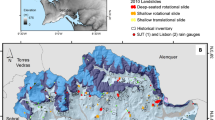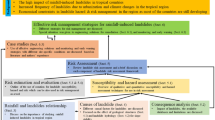Abstract
This study shows a rockfall susceptibility assessment at local scale in north Beijing of China, including the identification of rockfall sources onsite by terrain and rock discontinuities analysis and run-out distance prediction by Rocfall™ simulation. Two types of rockfall were defined including one type on the cliffs with long inclined slopes and another type on the road slopes with low height. Two historical rockfall events were used to back-calibrating the parameters used for run-out distance simulation. Based on the work, rockfall susceptibility map at local scale was created in GIS, which was compared with the map obtained at regional scale (entire Huairou district scale). Due to the difference of approaches applied, procedure of assessment and types of source data acquired, the two resulting rockfall susceptibility maps are proved to be different. Still, both of them are useful and could be used at different level’s decision for rockfall prevention and mitigation. Different types of uncertainties exist in the study of rockfall susceptibility assessment. To reduce the uncertainties, studies on both approaches and techniques are suggested.













Similar content being viewed by others
References
Akgun A, Dag S, Bulut F (2008) Landslide susceptibility mapping for a landslide-prone area (Findikli, NE of Turkey) by likelihood-frequency ratio and weighted linear combination models. Environ Geol 54:1127–1143
Alejano LR, García-Cortés S, García-Bastante F, Martínez-Alegría R (2013) Study of a rockfall in a limy conglomerate canyon (Covarrubias, Burgos, N. Spain). Environ Earth Sciences. 70:2703–2717
Aleotti P, Chowdhury R (1999) Landslide hazard assessment: summary review and new perspectives. Bull Eng Geol Environ 58:21–44
Ansari MK, Ahmad M, Singh Rajesh, Singh TN (2014) Rockfall hazard assessment at Ajanta Cave Aurangabad, Maharashtra, India. Arabian J Geosci 7:1773–1780
Ardizzone F, Cardinali M, Carrara A, Guzzetti F, Reichenbach P (2002) Impact of mapping errors on the reliability of landslide hazard maps. Nat Hazard Earth Syst Sci 2:3–14
Ayalew L, Yamagishi H, Maruib H, Kannoc T (2005) Landslides in Sado Island of Japan: part II. GIS-based susceptibility mapping with comparisons of results from two methods and verifications. Eng Geol 81(4):432–445
Azzoni A, La Barbera G, Zaninetti A (1995) Analysis and prediction of rockfalls using a mathematical model. International Journal of Rock Mechanics and Mining Sciences & Geomechanics Abstracts 32(7):709–724
Baecher GB, Christian JT (2003) Reliability and statistics in geotechnical engineering. Wiley, London, p 605
Barton N, Choubey V (1977) The shear strength of rock joints in theory and practice. Rock Mech 10:1–54
Bozzolo D, Pamini R (1986) Simulation of rock falls down a valley side. Acta Mech 63:113–130
Budetta P (2004) Assessment of rockfall risk along roads. Nat Hazards Earth Syst Sci 4:71–81
BMBGMR (Beijing Municipal Bureau of Geology and Mineral Resources (1991) Report of regional geology survey of Beijing, Geology Press,China
Carrara A, Cardinalli M, Guzzetti F, Reichenbach P (1995) GIS technology in mapping landslide hazard. In: Carrara A, Guzzetti F (eds) Geographical information systems in assessing natural hazard. Kluwer, London, pp 173–175
Cardinali M, Carrara A, Guzzetti F, Reichenbach P (2002) Landslide hazard map for the Upper Tiber River basin. CNR, Gruppo Nazionale per la Difesa dalle Catastrofi Idrogeologiche, Publication n. 2116, scale 1:100,000
Cevik E, Topal T (2003) GIS-based landslide susceptibility mapping for a problematic segment of the natural gas pipeline, Hendek (Turkey). Environ. Geol. 44:949–962
Chau KT, Wong RHC, Wu JJ (2002) Coefficient of restitution and rotational motions of rockfall impacts. Int J Rock Mech Min Sci 39(1):69–77
Chung CF, Fabbri AG (2003) Validation of spatial prediction models for landslide hazard mapping. Nat Hazard 30(3):451–472
Copons R, Vilaplana J, Linares R (2009) Rockfall travel distance analysis by using empirical models (SolAd’Andorra la Vella, Central Pyrenees). Natural Hazards and Earth System Sciences 9(6):2107–2118
Corominas J (1996) The angle of reach as a mobility index for small and large landslides. Can Geotech J 33:260–271
Crosta GB, AgliardiF FrattiniP, Imposimato S (2004) A three-dimensional hybrid numerical model for rockfall simulation. Geophysical Research Abstracts 6:04502
Cruden DM (1976) Major rock slides in the Rockies. Can Geotech J 13:8–20
Dai FC, Lee CF, Ngai YY (2002) Landslide risk assessment and management: an overview. Eng Geol 64(1):65–87
Dorren LKA, Berger F, Putters US (2006) Real-size experiments and 3-D simulation of rockfall on forested and non-forested slopes. Natural Hazards and Earth System Sciences 6:145–153
Evans SG, Hungr O (1993) The assessment of rockfall hazard at the base of talus slopes. Can Geotech J 30(4):620–636
Fall M, Azzamb R, Noubactep C (2006) A multi-method approach to study the stability of natural slopes and landslide susceptibility mapping. Eng Geol 82(4):241–263
Fell R, Corominas J, Bonnard C, Cascini L, Leroi E, Savage WZ (2008) Guidelines for landslide susceptibility, hazard and risk zoning for land use planning. Eng. Geol. 102:85–98
Frattini P, Crosta GB, Carrara A, Agliardi F (2008) Assessment of rockfall susceptibility by integrating statistical and physically-based approaches. Geomorphology 94(3–4):419–437
Galli M, Ardizzone F, Cardinali M, Guzzetti F, Reichenbach P (2008) Comparing landslide inventory maps. Geomorphology 94:268–289
Guzzetti F, Carrara A, Cardinali M, Reichenbach P (1999) Landslide hazard evaluation: a review of current techniques and their application in a multi-scale study, Central Italy. Geomorphology 31:181–216
Guzzetti F, Reichenbach P, Ardizzone F, Cardinali M, Galli M (2006) Estimating the quality of landslide susceptibility models. Geo morphology 81:166–184
Guzzetti F, Crosta GB, Detti R, Agliardi F (2002) STONE: a computer program for the three-dimensional simulation of rock-falls. Computers & Geosciences 28(9):1079–1093
Hoek E, Bray JW (1981) Rock slope engineering. Institution of Mining and Metallurgy, London
Ulusay R, Hudson JA (2007) The complete ISRM suggested methods for rock characterization, testing and monitoring: 1974–2006. Kozan, Ankara
Jones CL, Higgins JD, Andrew RD (2000) Colorado rockfall simulation program version 4.0. Colorado Department of Transportation, Colorado Geological Survey, Colorado
Kouli M, Loupasakis C, Soupios P, Vallianatos F (2010) Landslide hazard zonation in high risk areas of Rethymno Prefecture, Crete Island. Greece. Nat Hazard 52(3):599–621
Lee S (2004) Application of likelihood ratio and logistic regression model for landslide susceptibility mapping using GIS. Environ Manage 34:223–232
Lee S, Sambath T (2006) Landslide susceptibility mapping in the DamreiRomel area, Cambodia using frequency ratio and logistic regression models. Environ Geol 50:847–855
Lee S, Pradhan B (2007) Landslide hazard mapping at Selangor, Malaysia using frequency ratio and logistic regression models. Landslides 4:33–41
Lee S, Ryu JH, Kim IS (2007) Landslide susceptibility analysis and its verification using likelihood ratio, logistic regression, and artificial neural network models: case study of Youngin, Korea. Landslides 4:327–338
Michoud C, Derron M-H, Horton P, Jaboyedoff M, Baillifard F-J, Loye A, Nicolet P, Pedrazzini A, Queyrel A (2012) Rockfall hazard and risk assessments along roads at a regional scale: example in Swiss Alps. Natural Hazards and Earth System Science 12(3):615–629
Nadim F, Einstein H, Roberds W (2005) Probabilistic stability analysis for individual slopes in soil and rock. In: Hungr O, Fell R, Couture R, Eberhardt E (eds) Landslide risk management. Taylor and Francis, London, pp 3–26
Palmström A (2005) Measurements of and correlations between block size and rock quality designation (RQD). Tunn Undergr Space Technol 20(4):362–377
Ruff M, Czurda K (2008) Landslide susceptibility analysis with a heuristic approach in the Eastern Alps (Vorarlberg, Austria). Geomorphology 94(3–4):314–324
Singh PK, Wasnik AB, Kainthola Ashutosh, Sazid M, Singh TN (2013) The stability of road cut cliff face along SH-121: a case study. Natural Hazards 68(2):497–507
Stevens W (1998) Rockfall: a tool for probabilistic analysis, design of remedial measures and prediction of rockfalls. Thesis, Department of Civil Engineering, University of Toronto, Ontario, M.A.Sc
Topal T, Akin M, Ozden AU (2007) Assessment of rockfall hazard around Afyon Castle. Environ Geol 53(1):191–200
Topal T, Akin MK, Akin M (2012) Rockfall hazard analysis for an historical Castle in Kastamonu (Turkey). Natural Hazards. 62(2):255–274
Varnes DJ, IAEG (International Association for Engineering Geology) (1984) Commission on Landslides and Other Mass Movements. Landslide hazard zonation: a review of principles and practice. UNESCO Press, Paris, 63
Van Westen CJ, (1997). Statistical landslide hazard analysis. ILWIS 2.1 for Windows application guide. ITC Publication, Enschede, pp. 73–84
Wang XL, Zhang LQ, Wang SJ, Agliarid F, Frattini P, Crosta GB, Yang ZF (2012) Field investigation and rockfall hazard zonation at the Shjing Mountains Sutra caves cultural heritage (China). Environmental Earth Sciences 66:1897–1908
Wang XL, Zhang LQ, Wang SJ, Lari S (2014a) Regional landslide susceptibility zoning with considering the aggregation of landslide points and the weights of factors. Landslides. 11(3):399–409
Wang XL, Frattini P, Crosta GB, Zhang LQ, Agliardi F, Lari S, Yang ZF (2014b) Uncertainty assessment in quantitative rockfall risk assessment. Landslides. (SCI) 11(4):711–722
Yalcin A, Reis S, Aydinoglu AC, Yomralioglu T (2011) A GIS-based comparative study of frequency ratio, analytical hierarchy process, bivariate statistics and logistics regression methods for landslide susceptibility mapping in Trabzon, NE Turkey. Catena 85:274–287
Yilmaz I (2009) Landslide susceptibility mapping using frequency ratio, logistic regression, artificial neural networks and their comparison: a case study from Kat landslides (Tokat-Turkey). Comput Geosci 35:1125–1138
Acknowledgments
The authors would like to thank the support of the National Natural Science Foundation of China (No. 41402285, 41030750, 41272353, 41172269, 41372322 and No. 40502027), China Postdoctoral Science Foundation (No.2013M530722), National Technology Support Project (2008BAK50B04), and the Chinese Academy of Sciences Key Deployment Project (KZZD-EW-05-02).
Author information
Authors and Affiliations
Corresponding author
Rights and permissions
About this article
Cite this article
Wang, X., Zhang, L., Ding, J. et al. Comparison of rockfall susceptibility assessment at local and regional scale: a case study in the north of Beijing (China). Environ Earth Sci 72, 4639–4652 (2014). https://doi.org/10.1007/s12665-014-3718-3
Received:
Accepted:
Published:
Issue Date:
DOI: https://doi.org/10.1007/s12665-014-3718-3




